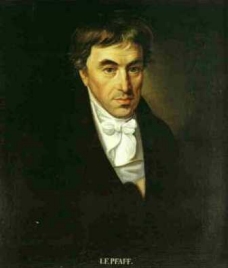Johann Friedrich Pfaff facts for kids
Quick facts for kids
Johann Friedrich Pfaff
|
|
|---|---|

Johann Friedrich Pfaff
|
|
| Born | 22 December 1765 |
| Died | 21 April 1825 (aged 59) |
| Nationality | German |
| Alma mater | University of Göttingen |
| Known for | Pfaffians Pfaffian constraint Pfaffian function Pfaffian system Pfaffian orientation |
| Scientific career | |
| Fields | Mathematics |
| Institutions | University of Helmstedt Halle University |
| Doctoral advisor | Abraham Kästner Johann Elert Bode |
| Doctoral students | Carl Friedrich Gauss August Möbius Karl Mollweide |
| Other notable students | Johann Christian Martin Bartels |
Johann Friedrich Pfaff (born December 22, 1765 – died April 21, 1825) was an important German mathematician. He was known as one of Germany's top mathematicians in the 1800s. He helped start a new way of thinking in German mathematics. This new way of thinking greatly influenced how mathematics grew in the 19th century, especially through his student, Carl Friedrich Gauss.
Even a famous French mathematician, Pierre-Simon Laplace, thought highly of Pfaff. When asked who the greatest mathematician in Germany was, Laplace said, "It's Pfaff." When someone mentioned Gauss, Laplace replied, "You're asking me about Germany, and Gauss is the greatest mathematician in all of Europe!" This shows how respected Pfaff was.
Contents
Early Life and Education
Johann Friedrich Pfaff was born in Stuttgart. He went to a special school called the Carlsschule. There, he became good friends with Friedrich Schiller, a famous German writer. From a young age, people noticed that Pfaff was very good at math.
He continued his studies at the University of Göttingen. His teacher there was Abraham Gotthelf Kästner. In 1787, Pfaff moved to Berlin. He studied practical astronomy with Johann Elert Bode, who was an expert in the stars.
A Career in Mathematics
In 1788, Pfaff became a professor of mathematics at the University of Helmstedt. He taught there for many years until the university closed in 1810. After that, he moved to the University of Halle. He continued teaching mathematics there for the rest of his life.
Pfaff studied many areas of mathematics. He worked on mathematical series, which are like long lists of numbers that follow a pattern. He also studied integral calculus, a branch of math used to find areas and volumes.
He is especially known for his work on something called "Pfaffian systems." These are special types of equations that are now part of a bigger math topic called differential forms.
Teaching Carl Friedrich Gauss
One of Pfaff's most famous students was Carl Friedrich Gauss. Gauss is considered one of the greatest mathematicians of all time. Pfaff was Gauss's official research supervisor. They knew each other well and even lived together in Helmstedt in 1798. Another important student of Pfaff's was August Möbius, who also became a well-known mathematician.
Key Works
Pfaff wrote several important books and papers. His main works include Disquisitiones analyticae maxime ad calculum integralem et doctrinam serierum pertinentes, published in 1797. He also wrote "Methodus generalis, aequationes differentiarum particularum, necnon aequationes differentiales vulgares, utrasque primi ordinis inter quotcumque variabiles, complete integrandi" in 1814-1815. These works showed his deep understanding of advanced mathematics.
Family of Scientists
Johann Friedrich Pfaff came from a family of smart people. His brother, Johann Wilhelm Andreas Pfaff, was also a professor of mathematics. Another brother, Christoph Heinrich Pfaff, was a professor who taught medicine, physics, and chemistry.
Images for kids
See also
 In Spanish: Johann Friedrich Pfaff para niños
In Spanish: Johann Friedrich Pfaff para niños
- Pfaffian


